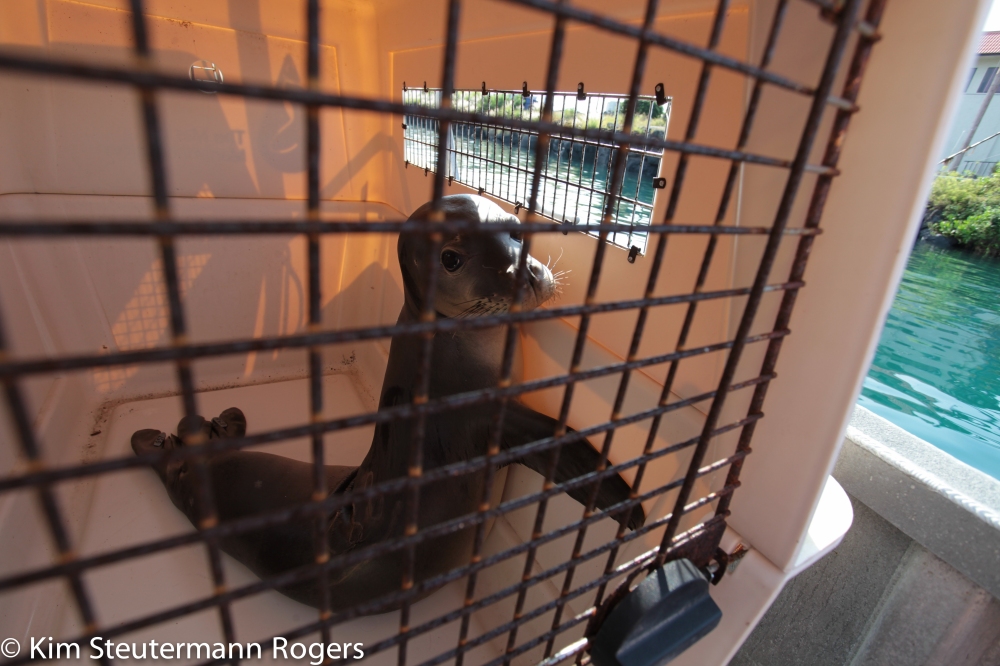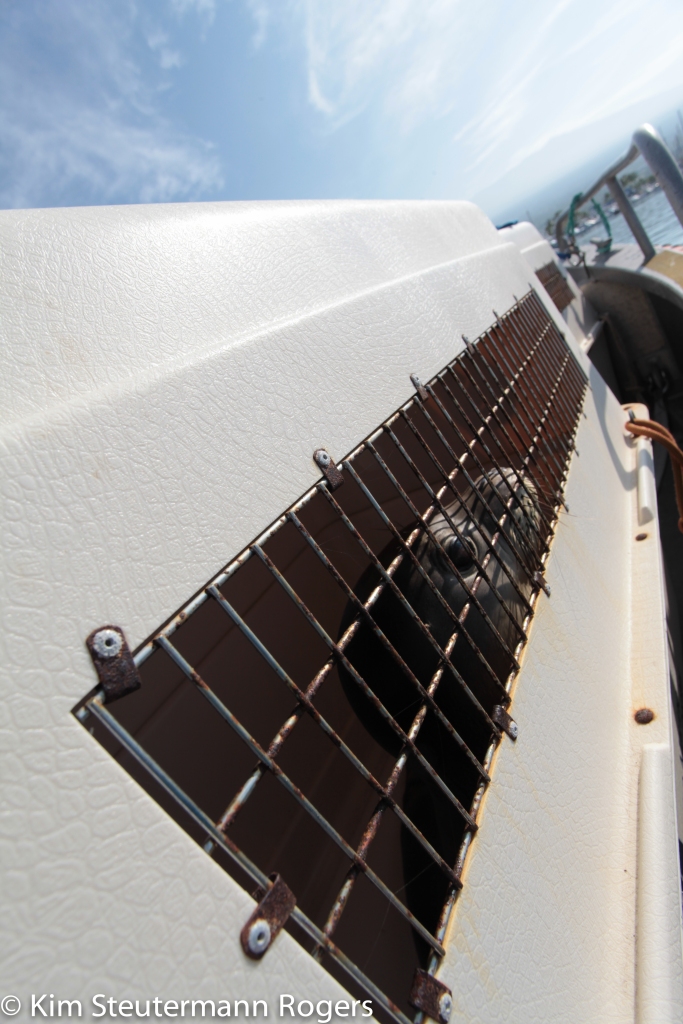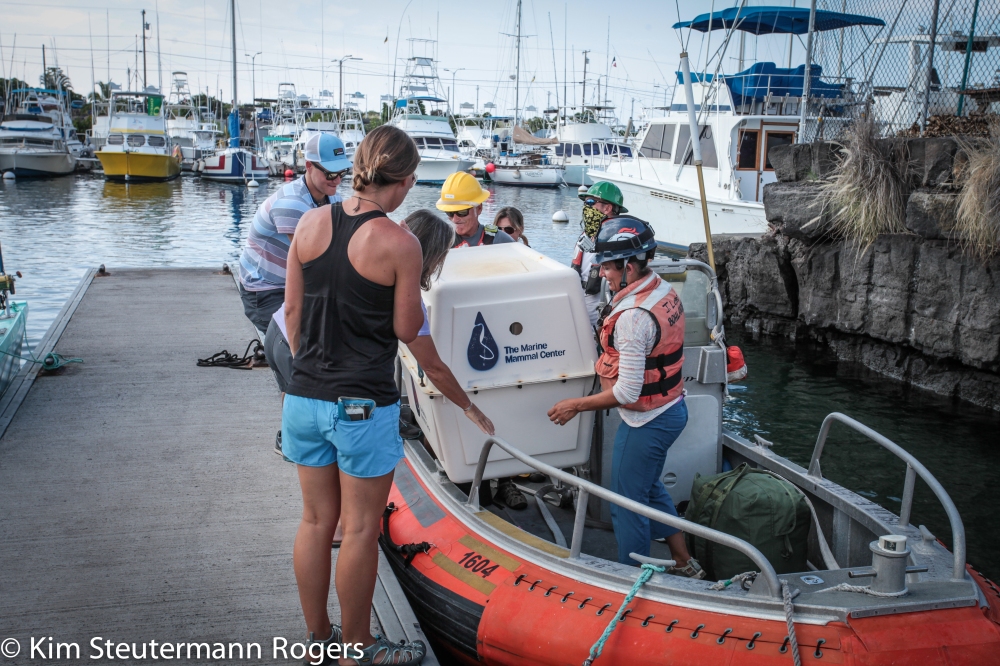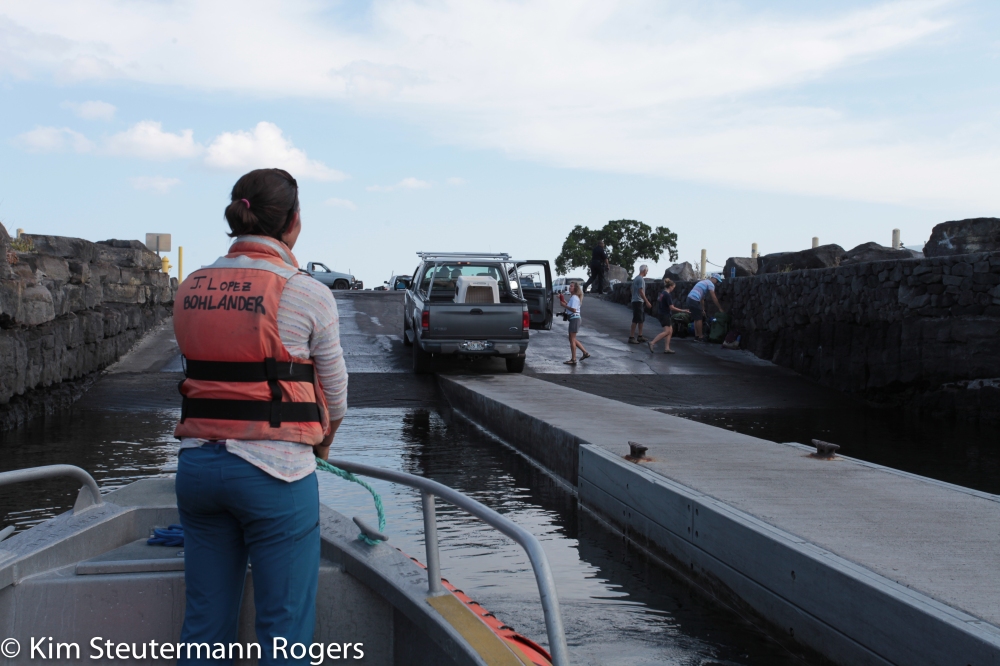The rocking and rolling woke me. We’d had a few rough nights throughout the voyage, but this was the worst. I found myself scrabbling for the bed sheets. But when I opened my eyes, I wasn’t in my bunk aboard the Oscar Elton Sette. I was in my bed at home on Kaua‘i, my husband beside me, one dog competing for space at my feet, and the other nestled in her bed on the floor.

My 28-day voyage with the Hawaiian Monk Seal Research Program came to an end on Friday, October 2nd after we’d made the 1,500-mile return journey from Kure Atoll to Ke Kai Ola, the Hawaiian Monk Seal Hospital located at Kailua-Kona on Hawai‘i (Big) Island.
In the waters off Kona, we gathered for our usual small boat meeting prior to shuttling monk seals to shore. The NOAA crew uses the GAR model of risk assessment before every operation, assigning a number from zero to 10 across six categories.
“We have seals on board that don’t have a lot of small boat experience, so I’m going to go with a four,” our Operations Officer said when it came to the category of mission complexity. Jared was often smiling, but he also wasn’t joking. “The most complex part of today’s mission is getting seals off the Sette and onto the SE4 safely.”

Two nights before, as we traversed the Kaulakahi channel between Kaua‘i and Ni`ihau, a large wave sideswiped the ship, frying a sensor that triggered a fire alarm at 1:00 a.m. And just like in drills, we mustered on the Texas deck. But, this morning, the winds and seas off Kona were light. Our total risk assessment added up to 23, falling into the green category, the lowest of the voyage.
Like every team on which I’ve played throughout my life, we capped the end of our meeting with a cheer. “Go, team.”
In the background, Neva called, “bwah,” and `Ena`ena made what I can only describe as the same noise my brothers liked to torment me with when we were kids—armpit farts. Seriously. In the weeks living with monk seals, I’ve learned a few new sounds they make, like the throat gurgling “whup” and chattering of teeth to go with the more typical sneezes, belches, and “gah” vocalizations. And armpit farts.

Captained by Mills and crewed by Chief Sci Jessie, the offload of seals took three runs. Neva went first. Then, `Ena`ena and Mahina. Lastly, Mo`o.
Some of you keen readers may be wondering about Ama`ama and Puka and scratching your heads about Mahina and Mo`o. In the tag-team world of underweight monk seals hitching rides aboard the Sette, Ama`ama and Puka scored an early departure off the ship—aboard a jet out of Midway—and they were already settled in at Ke Kai Ola, along with little Kilo from Ni`ihau. The last two, Mahina and Mo`o, were collected on our return when we picked up the French Frigate Shoals field team.
If you’re good with mathematical story problems, you’ve already figured out that seven underweight Hawaiian monk seals will be rehabilitated at Ke Kai Ola over the winter.
Before the existence of the monk seal hospital, run by the Marine Mammal Center of California, these seven monk seals would have faced grave odds in the wild. While the rate of overall population decline is decreasing, the greatest threat to the species’ occurs within the first three years of a seal’s life. Historically, one in five pups in the Northwestern Hawaiian Islands survive to adulthood. In competition for food resources among apex predators, the key is size. If monk seals reach the size of healthy three-year-olds, their chance of survival jumps to 70%. So, that’s where the medical rehabilitation center of Ke Kai Ola comes in. Young, underweight seals are removed from the wild, fattened up in rehabilitation, and, then, returned to the wild. Like Pearl and Hermes.

Speaking of food, our chief steward, Clementine, may have saved her best recipes for our last night on board, dishing up kalua pork, pork luau, grilled chicken, and grilled turkey tails for the meat eaters; king crab for the seafood lovers; and wild rice, avocado salad, corn on the cob, wild rice, macaroni salad, watermelon, and paniolo cornbread for the vegetarians.
As overused as the cliché may be, when it comes to the galley, Clem runs a tight ship. On my first day aboard, when I reached for a plate at the buffet line, Clem called, “Wash your hands.” And when I followed the counter-clockwise instructions on entering the galley to scrape and rinse my plate, I could feel her eyes investigating what scraps I’d left uneaten. I felt the same guilt from childhood dinners when I didn’t clean my plate as instructed. By the end of the voyage, however, instead of calling out, “Wash your hands” when I entered the galley, Clem was saying, “Ray, get the veggie eggs benedict.” Or veggie quesadilla. Or veggie pizza. But it wasn’t just me. Clem catered to everyone’s diet. As the weeks went on, I noticed the menu board got more descriptive. For those with lactose intolerance, “no butter” or “non-dairy” would be added to the Apple pancakes or chicken potpie.

So, when Clem requested a local newspaper while we were shuttling seals in and out of the harbor at Kona, our small boat crew of Mills, Jessie, and me complied. And when the first harbor store turned up zero newspapers, we tried another. With every stop, Mills radioed the ship to let them know our whereabouts. But when our shopping errands seemed to take too long, the ship inquired as to just what the heck we were doing. Because technically, shopping was not part of our day’s mission.
“Picking up a local newspaper per Clem’s request,” Mills answered.
There may be a CO and XO—commanding officer and executive officer—aboard the ship, but everyone knows it’s really Clem who runs the ship. So, after a brief pause, the answer to the above transmission went something like, “Roger that. Carry on.”
Within hours of our return to the ship—newspaper safely delivered to Clem—it was time to dance again. A text from Ke Kai Ola reported: All four newly deposited monk seals at Ke Kai Ola were already eating fish.
Motoring to Honolulu, our disembarkation point, that night, it was quiet on the fantail of the ship without the monk seals. As one group of scientists and crew played poker in the galley and another group watched L.A. Confidential in the movie room, I spent a moment by myself among the now empty transport carriers that had housed some monk seals for what I hope will be a brief moment in their long lives.
I had boarded the Sette with one question weighing on my mind: What does it matter if the Hawaiian monk seal goes extinct?
As a volunteer with the program, providing educational outreach to people on the beach, I am often asked that question—sometimes by children, sometimes by fishermen, sometimes by visitors. I was hoping to come up with a thoughtful answer during my time on the ship after conversations with the people closest to the species. Surely, after speaking with a few scientists, I could come up with an intelligent answer. One that would embolden children and adults, advocates and adversaries, and residents and visitors alike to agree that saving the Hawaiian monk seal was important.
But did I?
No.
Standing on the fantail of the Sette, gazing at the stars above, thinking there could be a celestial body in the night sky above that was around when the first monk seal swam across the then watery passageway from the Caribbean to Pacific Ocean, I concluded what matters is this: People working together to help someone or something in need. For 28 days, I watched a group of people come together to serve something other than their own personal wellbeing, and it was an awesome thing. An empowering experience. I hope to spend the rest of my life surrounded by these kinds of people in these kinds of efforts.
Now, if only this vertigo would go away.

What????? You two are not coming to the concert?
Sent from my iPhone From paradise
>
LikeLike
Mindy, I’ve been on a ship in the middle of the Pacific Ocean for the past 28 days. What concert? When?
LikeLike
Wow, I feel jealous and inspired. What a good heart you have, Kim, to dedicate so much of your time and energy and love to do good work for other creatures. I have been harboring a katydid in my living room, feeding him organic romaine lettuce for a month now, but I am going to have to step it up over here …. For real.
LikeLike
I’m impressed you could keep a katydid alive for a month. Well done.
LikeLike
Welcome home, Kim. Sure Eric is glad to have you back no enjoyed reading your posts a great deal. Mahalo!
Sent from my iPhone. Please forgive any auto correct words that are out of context, and other errors
>
LikeLike
It’s good to be home, for sure, but a part of me wishes I were still at sea!
LikeLike
Sounds like a once in a lifetime experience. Thanks for taking us along.
LikeLike
It was. But I hope it wasn’t! Thanks for reading and commenting;-)
LikeLike
What a lovely and inspiring post. I’m glad you made it home safely and that you shared your trip with us!
LikeLike
Thanks for coming along for the ride!
LikeLike
Did I miss #11 somewhere?
LikeLike
Ha! No, you didn’t. Thanks for catching that;-)
LikeLike
The best of the best! Welcome home. Try Antivert (Meclizine)
LikeLike
That’s funny. Because I took Meclizine a few days while I was at sea!
LikeLike
People’s response to your guiding question, “What does it matter if the Hawaiian monk seal goes extinct?” is the crux of the solution for seal survival. IMO, we need to connect people to the seals in a way that is meaningful to them (the people!) Your writing and photography has done that for a lot of us. Who can turn away from your photo, “Ena`ena Is All Eyes” and say it doesn’t matter if Hawaiian Monk Seals go extinct?
LikeLike
Thanks, Barb. I agree that connection/story/meaning makes all the difference in whether or not someone gets behind saving a species–or just caring about it. Still, I am searching for that one answer to the question that stops people in their tracks and makes them nod in their heads. Alas, like there is no one, easy answer for why the monk seal population is declining in the Northwestern Hawaiian Islands, I am coming to accept that there is no one answer to my question. (Well, not really MY question but the question lodged in my brain by a young boy I met on the beach one day while I was pup-sitting a few years ago;-)
LikeLike
“we need to connect people to the seals in a *way that is meaningful to them* “…. Therefore, we’ve got our job cut out for us!… because each person will connect to the seals in an individual way.
IMO, I don’t think there is one answer that will stop everyone, for a “light bulb” moment (although I think some answers are better than others and will reach more people). Finding scientific answer(s) will work for some people; other people won’t find a connection through statistical treatment of data, but rather by looking a seal in the eyes or hearing of another person’s experiences with seals.
We just gotta have a bag full of tools; I wonder what tool would have best connected that young boy to monk seals?
LikeLike
Kim I have so enjoyed your postings. I’m sorry it’s over. Your accounts are so immediate descriptive compassionate and funny all at the same time. I leave on Saturday for Kauai. Look forward to seeing you soon. Marcia
Sent from my iPhone
>
LikeLike
I’m sorry it’s over, too. Visiting the Northwestern Hawaiian Islands in this way felt like speed dating. Maybe, some day, I’ll be able to spend a significant amount of time on one or more of the islands/atolls and really get to know the place;-)
LikeLike
My response to that seemingly innocent question…because they’re a part of what makes Hawaii unique. Hawaiian monk seals are found nowhere else in the world. They are a symbol of nature evolved and remodeled in the gentlest ways possible in the relative isolation of the Hawaiian island archipelago. I know…sounds naive…but I just returned from hiking in Kamakou Preserve on Molokai and it too, like the monk seal, deserves protection and conservation for that reason, because there is nowhere on earth like it. I’m not a scientist or a biologist or anything. But experiencing encounters with those amazing creatures (I’ve seen them on land and been in the water when one swam near) and in magical places like the cloud bog in Kamakou absolutely instilled in me a sense of awe and wonder and respect for this place, for this Hawaiian place I call home. And it makes me want to do what I can to ensure that they are around to inspire future generations of scientists, biologists or just everyday people looking to be touched by something real. That would be my answer ☺.
Thank you so very much for sharing your stories and experiences. I’ve shared many of them with friends and coworkers who I know have passed them on to others, too. You are making a difference!
Paula
LikeLike
Thanks, Paula, for sharing your thoughts and these stories. We have a bog on Kauai that I suspect is similar to yours on Molokai, and I so agree that it is a special place. Innocent questions can be so profound, as I found this one mentioned above. And while I search and search for some profound answer, I think you are so right when you say monk seals deserve saving because they are unique to this place.
LikeLike